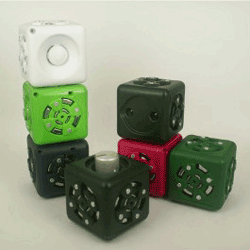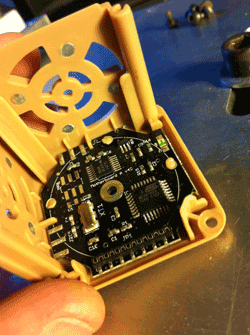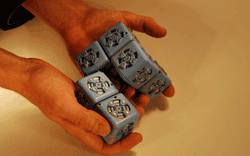New toy teaches fundamentals of robot building
Modular Robotics, a spin-off company from Carnegie Mellon University, is about ready to release its much-hyped new robot construction toy, “Cubelets.”

Give your kids an early start with this fun robotics toy.
Cubelets are a bunch of easy-to-handle blocks that offer children (8+) and early robot hobbyists a fun and simple way to learn how to build and program robots. Here’s how:
The blocks

There are four types of Cubelet blocks.
Cubelet blocks form robots by magnetically snapping together. The blocks themselves come in four types: sense blocks, action blocks, think blocks, and utility blocks. Sense blocks are black, action blocks clear, and think and utility blocks are different colors.
Each block has connecting faces that have three conductors on them: The outer ring and magnets conduct ground; the inner metal ring conducts power; and the center pin conducts data from one Cubelet to the next. All three conductors must magnetically connect with their neighboring counterparts in order for the robot to function.
Programming

The unique programming behind the Cubelet takes out much of the complexity of robotics.
When constructing a robot, it’s not just a matter of which blocks are used, but, more important, how they get placed. Cubelets arranged in different physical configurations will result in different robot functionality (including driving around the floor, reacting to light, and various other behaviors).
Cubelets don’t require the user to program or wire anything whatsoever, a feature vastly different from the procedural programming used with normal robots; that is, where behavior is a result of executing a sequence of instructions in a microcontroller. Each Cubelet block is its own microcontroller, and the robot functions via distributed programming. Its behavior is based entirely on local reactions between the different blocks.
This is what makes Cubelets so great for children and early robot hobbyists: There isn’t a single microcontroller to act as the robot’s brain here, and there’s no sequence of instructions either. There are no variables, functions, or procedural logic. It’s simple trial and error.
Functionality

Cubelets are remarkably easy to use.
Each Cubelet has a small LED in one corner. When a robot is built and its battery block turned on, the LED light comes on to show that the block is getting power and talking to its neighbors.
Speaking of the battery block, it has a small switch for easy on/off functionality. It comes with two rechargeable lithium-iron-phosphate (LiFePO4 , or LFP) cells. To recharge them, you need only unscrew and remove the cover, and place the cells in the charger.
Custom programming
Modular Robotics has stated that while older kids and advanced users can’t exactly customize their Cubelets just yet, the company is working on this capability. In fact, it already has a Bluetooth Cubelet in the shop that is being tested. If all goes smoothly, it will allow users to connect the Cubelet to a PC or phone, see the code that the block is running on, and modify it via a web-based IDE.
The programming language will initially be C, but the company is working on an API and playing with other languages that could help make the system more accessible to younger kids.
Learn more
There are a limited number of Cubelets available for preorder. If you place an order now for a kit, you can expect them to ship out by early April.
Learn more about Cubelets at the Modular Robotics web site: modrobotics.com ■
Reference and pictures for this article via: modrobotics.com
Advertisement
Learn more about Electronic Products Magazine





